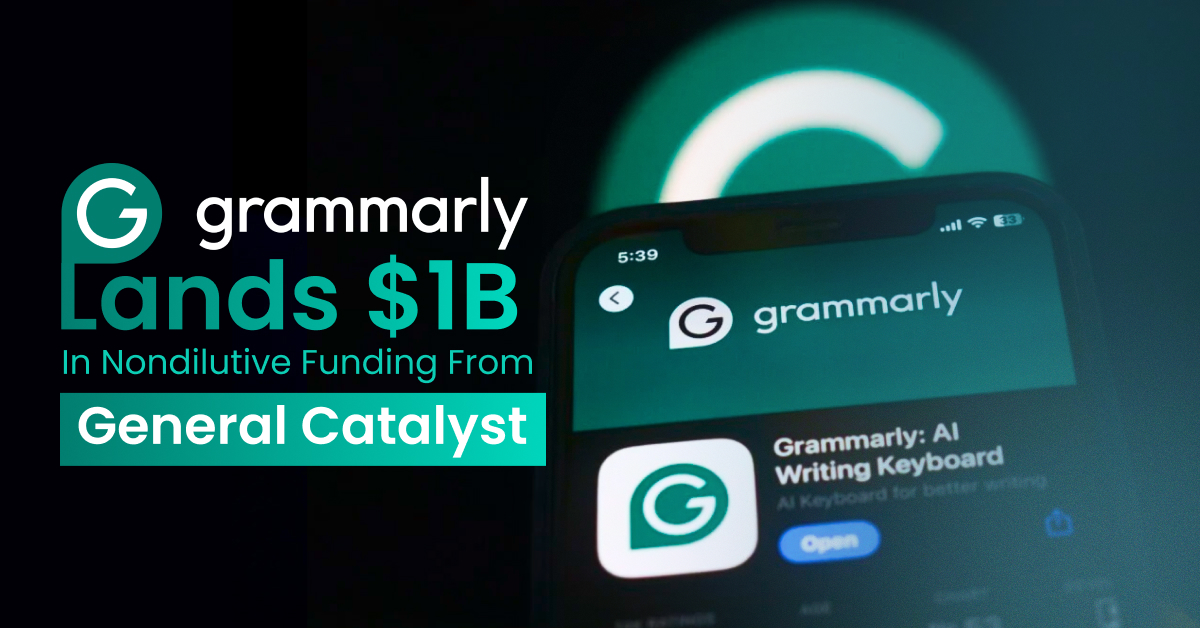Grammarly, the well-known AI-powered writing helper, has revealed that it has successfully closed a huge $1 billion in non-dilutive financing from General Catalyst, a venture capital giant.
This could change how support for early-stage businesses works. This important deal, which shows Grammarly’s strong financial success and its ambitious move toward a full AI efficiency platform, is one of the biggest investments made by General Catalyst’s Customer Value Fund (CVF).
You won’t find this kind of venture capital round very often. Important: The word “non-dilutive” is used. In traditional stock investments, a business gives up a piece of its ownership in exchange for money. This way of financing allows Grammarly to get a lot of cash without diluting the founders’ and current partners’ ownership.
1. What Exactly Happened?
On May 29, 2025, Grammarly financing round of funding was seen before. General Catalyst is not buying shares of a company like most venture capital firms do. The CVF instead sets up payments as a limited share of Grammarly’s profits, which lets the company grow without losing its value.
This funding supports:
- Scaling sales and marketing
- Accelerating strategic acquisitions
- Fast-tracking product and AI innovation
App like Grammarly wants to build the next generation of office tools by using its strengths, more than 40 million daily users and $700 million in annual revenue, to make them even better.
2. Why Non-Dilutive Funding Matters
With it nondilutive funding, it keeps all of its control while getting a huge boost in cash. The plan is based on how well the company makes money, not how much it is worth. General Catalyst funds pay back by taking a set portion of the money that is made with the capital, up to a certain limit.
This benefits both parties:
- It is great for long-term strategic investments because it doesn’t give up ownership or lower value.
- Grammarly General Catalyst investment makes sure of steady returns without the hassles of company ownership.
The model encourages fast customer capture and long-term growth because it is linked to ongoing income.
3. What Will Grammarly Do Next?
Our new CEO, Shishir Mehrotra, who used to work at Coda, is ready to make big moves. They’ve laid out a few main goals for growth:
a. Expanding GTM with Precision
Grammarly wants to grow its reach across both B2C and B2B markets, from college students to large businesses around the world. The money helps with strong marketing and sales in groups that haven’t been reached yet.
b. Strategic Acquisitions
Grammarly wants to make more smart purchases now that it has bought companies like Coda in the past. These will improve features like working together on documents, using workflow tools, and connecting to other apps, making it even stronger as an AI “agent platform.”
c. Product Innovation
Grammarly’s growth strategy is based on strong AI agents that are built into all of its interactions, from checking language to fine-tuning tone and UI feel. When you mix Coda and Grammarly, you get powerful context-aware tools that you can use in emails, documents, and wikis.
4. From Writing Assistant to AI Agent Platform
Today, Grammarly transcends simple grammar correction:
- It runs tools like safety filters, AI detectors, tone suggestion, editing, and paraphrasing.
- It works perfectly with more than 500,000 apps and websites, which affect millions of people every day.
- With innovations like Coda Brain and the purchase of Coda, Grammarly is becoming more integrated into daily work, intelligently surfacing data, improving team processes, and providing live ideas that are aware of the context.
This higher ranking shows that Grammarly is changing the way people work by not only fixing mistakes in text but also making work better.
5. New Leadership: Mehrotra’s Mandate
After buying Coda, It made Shishir Mehrotra CEO in December 2024. This showed that the company wanted to change from a one-time-use app to an AI-powered platform. Mehrotra adds product vision and growing skills that are fit for large businesses.
When asked about the time of the IPO, he said:
“I’m focused on making sure we’re innovating… When we feel ready, we’ll go public.”
6. Financial Strength & Market Position
It capital raised more than $550 million before, and in 2021, the business was worth $13 billion.Today, it’s been self-funded to make money with:
- $700M+ in annual revenue
- High gross margins (~80%)
- 97% retention among paid customers
The new Grammarly funding news underscores investor trust in its business fundamentals and scalability.
7. Competition & Market Dynamics
Even though ChatGPT, Microsoft Copilot, and other AI companies are in the same market, It has clear advantages:
- Context-Aware UX: It’s in-line edits make writing faster and easier.
- Broad Integration: Including browsers, apps, and business stacks.
- Product Depth: When you combine Grammarly and Coda, you get a unique environment.
Liz Miller and other researchers assert that Grammarly “captures the intersection of language and AI,” indicating a focus on impact rather than mere discourse.
8. A Broader Funding Trend
Grammarly billion dollar funding is part of a larger trend toward funding that doesn’t dilute the company’s profits. The CVF at General Catalyst is separate from their venture capital business and has invested in almost 50 growth-stage companies, focusing on stable returns over losing stock.
This plan works well for mature startups like Lemonade and Fivetran because it gives them growth cash without giving up ownership.
9. IPO Possibilities
It hasn’t set a date for its initial public offering (IPO), but the investment helps the company get ready for one in the future. If Grammarly decides to go public, they will be in a good situation because they have a better product line, more ways to sell their products, and good financial numbers.
10. What This Means for Users & Developers
- Better writing tools, collaboration features, and team connections are some of the faster improvements that help users.
- Customers in the enterprise sector benefit from productivity boosts, more detailed data, and better ways to communicate.
- Soon, third-party coders will be able to use it’s hosted tool environment, which will allow it to be used in more situations.
11. The Ukrainian Origin & Global Mission
It was started by Alex Shevchenko, Max Lytvyn, and Dmytro Lider in 2009 in Ukraine. The site now helps millions of people around the world, which supports its goal to improve the clarity and efficiency of conversation.
12. Analyst Insights
Nick Patience from Futurum says that the investment is a clear sign of it’s possible return on investment (ROI):
“They were one of the original companies doing this… using text analysis and generating content.”
People see the company as more than just a language tool; they see it as a platform that could change how people and businesses talk to each other.
13. What’s Next
Expect Grammarly to:
- Add powerful AI features to all of your settings.
- Add Coda’s features to processes where people work together.
- Add carefully chosen third-party tools
- Try to make smaller smart purchases.
- Increase business and world reach
Having the money and the right people in charge shows that you are ready for the next step.
Final Takeaway
Grammarly $1B funding investment from General Catalyst, which won’t dilute the company, is a brave move that:
- Keeps founder power and a high value
- Focuses on progress that is driven by revenue
- Encourages new ideas in AI-powered work tools
- Gets ready for an IPO while growing its business foothold
With a strong mix of technology, leadership, and business sense, Grammarly AI funding 2025 is the best partner for the modern workplace. Users and writers can look forward to a better, smarter, and more linked writing and work experience as it grows.





















